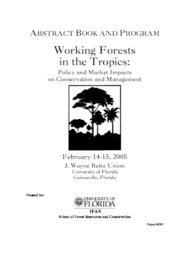Brazil nut population structure in thee sites in the Acre river valley, Brazil.
Brazil nut population structure in thee sites in the Acre river valley, Brazil.
Autoria: SERRANO, R. O. P.; WADT, L. H. de O.; KAINER, K. A.
Resumo: In the Amazonian state of Acre, Brazil, Brazil nuts (Bertholletia excelsa H.B.K.) have been commercially collected for almost a century by traditional populations inhabiting the forests of the Acre River Valley. Brazil nut fruits fall to the ground in December through February when extractivists work almost exclusively in the collection and opening of these fruits to release the commercially valuable seeds or nuts. Based on income generated and labor utilized, this is the most important non-timber forest product activity in the state. Nonetheless, little is known about collection impacts on population structure. This study evaluated Brazil nut population structure in three traditional rubber tapper estates (sites) located in the municipalities of Xapuri and Brasiléia where the species occurs naturally: Filipinas, Cachoeira, and São Francisco Figueiredo.
Ano de publicação: 2005
Tipo de publicação: Resumo em anais e proceedings
Unidade: Embrapa Acre
Palavras-chave: Acre, Acre River Valley, Amazonia Occidental, Amazônia Ocidental, Bertholletia Excelsa, Brasiléia (AC), Brazil nuts, Castanha do Para, Castanha do brasil, Dinámica poblacional, Dinâmica Populacional, Nuez del Brasil, Population dynamics, Seringal Cachoeira, Seringal Filipinas, Seringal São Francisco Figueiredo, Vale do rio Acre, Western Amazon, Xapuri (AC)
Observações
1 - Por padrão são exibidas publicações dos últimos 20 anos. Para encontrar publicações mais antigas, configure o filtro ano de publicação, colocando o ano a partir do qual você deseja encontrar publicações. O filtro está na coluna da esquerda na busca acima.
2 - Para ler algumas publicações da Embrapa (apenas as que estão em formato ePub), é necessário ter, no celular ou computador, um desses softwares gratuitos. Sistemas Android: Google Play Livros; IOS: iBooks; Windows e Linux: software Calibre.
Acesse outras publicações
Acesse a Base de Dados da Pesquisa Agropecuária (BDPA) para consultar o acervo completo das bibliotecas da Embrapa.

